McDonalds still sells the Quarter Pounder.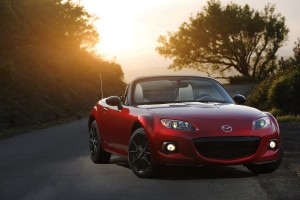
McRibs have come and (thankfully) gone.
Similarly over at Mazda. Since 1989 – the first year for the Miata – many other Mazdas have come … and gone. Not necessarily because they weren’t appealing cars (a twin-turbo RX-7 is very appealing) or even because they were bad cars (like the Millennia, which wasn’t).
It’s just that they were too much – or too little. Or they just lacked that intangible something that the Miata has had since Day One.
And still has today.
From the get-go, it was everything that made British sports cars so emotionally involving – without the emotional angst that came with unreliable, rust-prone, leaky/intermittent electric problems British sports cars. Much less the expense that came with German sports cars.
Durable as a Corolla – but unlike a Corolla, a track day implement that made you feel great on track and off. Race it on Sunday, drive it to work on Monday.
For the next 150,000 miles.
And now – hold your breath – an “all new” Miata is on deck for model year 2016, meaning it’ll be available for sale next summer or fall. It will reportedly be smaller – and lighter – and could possibly have a turbo engine.
It might also have a higher price tag, too.
So:
Should you wait?
Or buy the current car … in case they mess up the new car?
The Miata, of course, is everyone’s favorite British sports car – made by the Japanese. It’s a compact-sized two seater, available in either soft or retractable hardtop versions.
Base price is $23,970 for the Sport with soft top and five-speed manual transmission. The same car with six-speed automatic starts at $26,230.
A Grand Touring – with more power options and a six-speed manual transmission – lists for $26,905. With the folding hardtop, the sticker is $28,665.
For 2015, Mazda is offering a “kitchen sink” 25th Anniversary Edition that comes with every Miata option included (including the retractable hardtop) as well as some equipment specific to this model, such as a special wheel/tire package and interior trim upgrades. The six-speed manual-equipped version stickers for $32,205. With the automatic, the price is $32,655.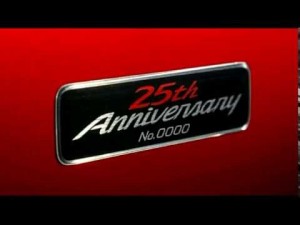
At its entry price point, the Mazda has no direct competition – because there’s no other RWD convertible available for just under $24k. Even the top-of-the-line 25th Anniversary Edition is a steal compared with something like a BMW Z4 roadster – which starts at nearly $50k.
The Miata’s closest-in-kind (and price) cross-shop is the Scion FR-S (base price $24,900)and its Subaru twin, the BR-Z (base price $25,695). However, they’re slightly larger cars (with four seats)and come only in hardtop coupe form.
Which pretty much leaves the Miata in a class by itself.
WHAT’S NEW
This is the final year for the current (4th generation) Miata.
An “all new” Miata will debut next spring.
In the meanwhile, Mazda is offering a 25th Anniversary Edition, as described above.
Also: Base Sport roadsters get a new (and nicer) cloth soft-top instead of the previous vinyl soft-top.
WHAT’S GOOD
As enjoyable as ever.
As affordable as ever.
Not as much of a strutter – or cop bait – as the Sciobaru “twins.”
Though very small, it fits big people.
WHAT’S NOT SO GOOD
Big price bump (about $3k) to get the six-speed manual.
Pack light.
All Miatas are powered by the same 2.0 liter, in-line four. However, rated power output differs depending on the transmission you choose.
With the manual – either the standard five-speed manual or the optional six-speed manual – the engine produces 167 hp.
But if you choose the optional six-speed automatic, output droops to 158 hp – a significant downgrading.
Torque output (regardless of transmission choice) is 140 ft.-lbs. at 5,000 RPM.
With the manual (either one) a Miata can do the 0-60 run in the low-mid sixes – about the same as the Scion-Subaru twins (when ordered with their manual six-speed transmissions).
But with the automatic – and the down-powered engine – the Mazda’s acceleration is much more muted. As I noted in my review of the Scion FR-S (see here) a small-engined/sans turbo car with an automatic transmission almost always feels slightly sluggish compared with the same car equipped with a manual transmission, due to the small engine’s fairly low torque output – and the comparatively high RPM at which this torque is produced. (Again, assuming there’s no turbo to boost power at low RPMs.)
In a manual-equipped car, you can rev the engine up (to where it makes power) before releasing the clutch. In an automatic car, it takes a moment for the revs to build – and power to be made.
Hence the acceleration lag.
However, the Miata’s torque peak arrives earlier – at 5,000 RPM vs 6,600 RPM in the FR-S/BRZ. The Miata is also lighter by several hundred pounds (2,480 vs. just over 2,700 lbs.) and this makes the automatic-equipped Miata a bit less sluggish-feeling than the automatic-equipped Sciobarus – which do the 0-60 run in the low-mid eight-second-range.
Gas mileage-wise, the pick of the Miata litter turns out to be the five-speed manual model, which rates 22 city, 28 highway. Models equipped with the six-speed automatic register 21 city, 28 highway.
Models equipped with the closer-ratio six-speed manual get the same 21 city, 28 highway. 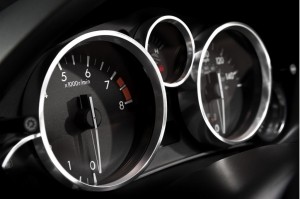
Interestingly, the Mazda’s mileage is not nearly as good as the Sciobaru twins, despite those cars being heavier (and somewhat more powerful, with 200 hp engines). With the automatic, an FR-S (or BRZ) rates 25 city, 34 highway – a respectable (and noticeable) 6 MPG difference on top. Even with the manual transmission, the “twins” do better, MPG-wise, than the Miata: 22 city, 30 highway.
In both cases (all three cases, actually) there is room for improvement.
One of the things to expect from the pending 2016 Miata is better mileage. Probably at least 35 MPG on the highway – necessary, given that 2016 is the year the federal government’s 35.5 MPG average fuel economy requirement goes into effect. Individual cars within a given car company’s model lineup that don’t make the cut will hurt their brand’s overall Corporate Average Fuel Economy (CAFE) numbers – which can mean “gas guzzler” penalties that are then passed on to consumers, making the car so saddled less appealing to potential buyers.
If Mazda can cut a couple hundred pounds off the Miata’s curb weight – which the rumor mill says they are working on – 35 on the highway ought to be very doable.
Wait and see.
Ever ride a .45 hollow point, Major Kong style?
For the past 25 years at least, the car industry has been doing everything conceivable to turn cars into not-cars. That is, into anodyne metal and plastic cocoons meant to isolate us from the external world – and keep the “fuss” of driving to an absolute minimum. From triple insulated door seals to automated manual transmissions, launch control, lane keep and braking “assist” – the driver is being systematically taken out of the drive.
And for the past 25 years, the Miata has been the antidote to all of that.
You can’t help but drive this car.
There is just enough power to play with – but you’d better be paying attention. To the gear you’re in at any given moment – and the gear you’ll need to grab at the next moment. The car is happiest when the engine is kept singing – and that’s entirely up to you.
Be involved.
It is almost impossible not to be.
The stubby shifter – and its short, mechanically gratifying engagements – is an absolute ball to play with.
At 80 it feels – and sounds – like you’re doing 100. The rush of the slipstream; the delightful buzzing of the engine.
As in all truly great driver’s cars, a radio is superfluous.
Needless to say, the handling is brilliant. Needless, because everyone who knows the Miata already knows it. Its reputation precedes it. Tape the headlights, put a number on the door – you’re ready for SCCA club racing. Or just balls to the wall on the street. Which you can actually do, not merely because the car is capable of it, but because you can afford this car.
And because this car runs under the radar.
It does not chum the waters and draw the bullet head boys like sharks to a flailing seal – as an FR-S or BRZ (and most definitely a Z4 or a Porsche Cayman or a new Corvette absolutely will, every time). The constant fear – the feeling that you are being watched and dare not; that even a few MPH over the limit is risking too much … it doesn’t exist when driving a Miata.
That is a huge plus.
So also the car’s ride. Which is much softer than you’d expect, despite the car’s ability to bob and weave. Very everyday livable. Visibility is superb, even in hardtop models – because of the more upright seating position and because of the car’s general diminutiveness.
When it’s time to find a spot to park, almost any spot will do. Zip right on in – usually, without having to back up, then in – repeat.
Zip right back out again when it’s time to split.
The Miata is intimately small – but not confining. You do not sit, Batman-like, hunkered low – as in the Scion-Subaru twins. It is one of the few (perhaps the only) new car in which it is still possible to roll the window down and rest your left elbow on the top of the driver’s side door as you motor on down the road.
Like those “small houses” that are becoming all the rage, the Miata’s designers made thoughtful use of all the available space. For instance – and unlike in the Scion/Subaru twins – the Miata’s twin cupholders are mounted in the center console where your right hand naturally falls … as opposed to unnaturally far back, such that getting at your coffee while the car is moving almost guarantees spillage. The emergency brake lever is mounted on the passenger side of the center console – where it’s not in the way of getting at whatever beverages you’ve got in those cupholders.
There is amply sufficient leg and headroom for a large man (6ft 3, about 200 pounds) to comfortably spend many hours in the car. The only deficit is the seats can’t be reclined for by-the-road cat naps; a function of the two-seater layout.
The trunk is also really small – 5.3 cubes. However, you can end-run this limitation by making use of the various other possible storage area, including the vertical cubby in between the seat backs and (in hardtop models) the area behind the back seats. Just remember not to drop the top with stuff back there.
The base Sport trim has everything a car like this needs – except for perhaps one thing. The six-speed manual transmission. This is perhaps the current car’s biggest negative relative to the Sciobaru twins, which both come standard with six-speed manuals. To get the manual six-speed (in lieu of the standard five-speed manual) one must buy the Club trim – which starts at $26,905. This is about a $3k bump over the base Sport – and also puts the Miata so equipped about $2k higher up than a base model Scion FR-S ($24,900).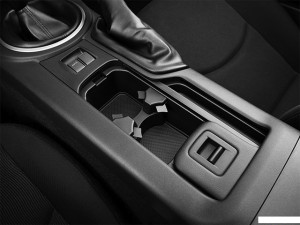
On the upside, once you’re at Club level, you can order a high-performance suspension package which includes Bilstein shocks and a limited-slip differential. Neither the FR-S nor the Subaru BRZ offer suspension upgrades from the factory.
THE REST
Mazda – god bless ’em – set the tension on the pull-up emergency brake tight. So that you can lock the rear wheels up to make a 90 degree turn (or a 180 degree turn). Believe it or not, in this dreary age of “safety,” most new car emergency brakes are set to prevent this. To have just enough tension to (barely) hold the car stationary when it is parked. But not enough to lock the rear wheels up when the vehicle is moving.
Saaaaaaafety first!
Also, the Miata’s traction control turns off – and does not come on again unless you, the driver, choose to turn it back on again.
Bless ’em – again.
This car is so perfect, the challenge to improve it is a daunting one. There is also the risk they’ll mess it up while trying. The next Miata might be lighter – and faster – as well as more fuel-efficient. But it may also cost more – and be more complicated.
So…
Buy one now … or later?
That is the question.
Throw it in the Woods?




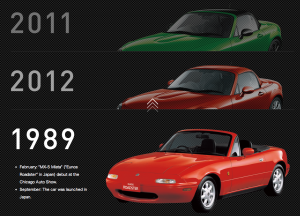




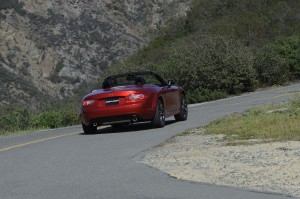







FYI:
Looks like MINI decided to hop on the Miata bandwagon. That is a good thing.
This Is The MINI We’ve All Been Waiting For
Read more: http://www.businessinsider.com/could-this-be-the-mini-weve-all-been-waiting-for-2014-9?op=1#ixzz3ETcbLp3r
One of the most tantalizing cars at this year’s Paris Auto Show will be the MINI Superleggera Vision.
In an age where cars are growing in size and weight, MINI has decided to move in the opposite direction. The Anglo-German brand teamed with Italian coachbuilders Touring Superleggera to create the sporty Vision concept. Although I haven’t been overly fond of MINI’s current trend of making bigger, bulkier vehicles, new car looks impressive to me.
At this point, the pint-sized two-seat roadster is just a design study. However, it’s not beyond the realm of possibility that at least some of the Vision’s features will make it into future MINI production cars. This thing is cool, so let’s hope MINI’s overlords at BMW do the right thing and put the Vision concept into production.
It is in good company. Many of the other, more luxurious retro two seat roadsters on the market today, especially the Z3, would not exist were it not for Miata showing the way.
http://static3.businessinsider.com/image/54243b5feab8ea6b7bc3e29c-1200/mini-superleggera-vision.jpg
http://www.businessinsider.com/could-this-be-the-mini-weve-all-been-waiting-for-2014-9
Be sure to watch the slide show at the link.
Several more shots of the MINI Superleggera Vision from different angles.
In it’s present form the Miata is a good roadster but if Mazda put in the turbo from the Speed3 if would be a GREAT ROADSTER.
http://en.wikipedia.org/wiki/Mazdaspeed3
Hi Matt,
Yes, but then it would no longer be inexpensive!
I think the turbo is a great idea… as an optionally available package or dealer installed accessory. But if Mazda were to make it standard, the Miata would become something else.
It would be another acceleration-focused (and touting) “speed” car.
There are already dozens of those.
Does the market need another?
They are great little cars and very inexpensive on the secondary market. Think I paid $3200 for a ’93 with 68K miles and a removable hardtop last year. Besides that they are a blast to drive.
Yup!
One of my perennial favorites. Inexpensive, all kinds of fun – and very hard to hurt.
Hi recently purchased a ’99 with a 5 speed manual. My first Miata and the car is a creampuff with only 60,000 miles on the clock. I swear I’ve never had so much fun driving as in this car. It’s completely changed my commute.
Not long after I purchased mine, I had an opportunity to drive an ’08 with the retractable hardtop and 6 speed auto. The car feels heavier and softer; not nearly as edgy as the ’99. I prefer the look of the MB as well.
Cheers,
Erik
Hi Erik,
No doubt, the retractable hardtop version feels heavier (top-heavier) because it is! But only slightly so.
Either way, the car is one of the greatest driver’s cars I have ever driven – and I have driven a lot of cars over the years. It’s not the quickest, nor the absolute best-handling. But it supremely enjoyable because it is so elemental and involving.
I wish I owned one myself.
Dear Eric,
Not sure where to ask this question. But Mazda once produced a rotary engine, albeit different from this engine, so I might as well ask it here.
What can you tell us about this engine design? Is the difference worthwhile? How does it compare with the Wankel?
Duke Engines’ incredibly compact, lightweight valveless axial engine
New Zealand’s Duke Engines has been busy developing and demonstrating excellent results with a bizarre axial engine prototype that completely does away with valves, while delivering excellent power and torque from an engine much smaller, lighter and simpler than the existing technology.
http://www.gizmag.com/duke-engines-axial/33631/?utm_source=Gizmag+Subscribers&utm_campaign=33fc13f728-UA-2235360-4&utm_medium=email&utm_term=0_65b67362bd-33fc13f728-91674581
Also, I’ve wondered why Mazda never put its rotary engine in the Miata. Cost maybe?
Hi Bevin!
The rotary engine makes a lot of hp for its size – and its small size reduces curb weight and improves packaging efficiency. However, its Achilles’ heel is its low torque output and (worse, these days) its penchant for excessive oil consumption. Great strides have been made using ceramic-tipped rotors (which seal more effectively) but – over time – these engines tend to get looser sooner (and burn more oil, which tends to make 02 sensors and catalytic converters unhappy, not to mention the EPA) and that’s why they’ve been more or less abandoned.
Dear Eric,
“… that’s why they’ve been more or less abandoned.”
Kinda sad. The idea of a non-reciprocating engine makes so much sense in terms of higher efficiency and lower vibration.
Too bad it couldn’t be made to work better.
Yup.
The problem is that tailpipe emissions standards are now so extreme – we are talking about fractions of a percent – that even though a modern rotary engine burns more cleanly than any reciprocating engine of the ’80s (and probably late ’90s and maybe even early 2000s, too) it has become de facto illegal to sell them in a new car.
Back in the late ’60’s Chrysler was showing of a gas turbine powered car, didn’t get to ride in it but saw it up close; the engine sounded like a giant vacuum cleaner. Anybody know whatever became of that idea?
Spot on about the emission standards nowadays, our rulers are so full of themselves they think they can change the laws of physics; striving for any extra percent of reduction at great cost. Meanwhile China burns cheap coal and eats our jobs, and all their pollution blows toward the USSA – what’s wrong with this picture? Not to mention what will happen to the atmosphere if that volcano in Iceland really blows its top.
Hi Mike,
I’ve seen the turbine cars, too. There were two issues with them (at the time):
Noise (there was concern that the consumer market would not cotton to the high-pitched/high-RPM sounds made by turbines).
Low-speed acceleration. It took unacceptably long for the turbine to spool up; or power delivery was too “peaky.”
Of course, this was 50-something years ago and probably both those issues would be non-issues today, with some tweaking….
eric, my cousin bought one of the first RX 7’s and I loved that car. First time I drove it, I over-revved it accidentally although it was none the worse for wear. I wouldn’t have even known it, just rowing through the gears and not paying attention to the tach but my cousin was and told me about it. It didn’t sound or feel like it was over-revving and I wasn’t running it hard so I never thought about it being over the 7500 rpm red line it had. That was a sweet little engine with a tab welded on top just like an a/c compressor for your house, no doubt the way it was installed on the assembly line. I could have picked that engine up one-handed and lifted it out of there.
He drove that car for 6 years and always kept his cars perfect. He gave $6700 for it new and drove it to Ca. where he put all the miles on it and then sold it for $6700 those 6 years later. According to him, the best damn car he ever had. He had a ’68 Vette at the time and probably sold it for nearly what he paid for that RX.
I recall when they made some factory racers with 4 rotor engines that did well in the Le Man’s series.
I just purchased a new lawn mower, a dead B&S on the old one and while I was looking at all the mowers I kept thinking how that little rotary would have fit right into most of them. So you’d need a radiator, big deal. I keep waiting for somebody to make a good water-cooled lawn-mower and chunk those air-cooled jobs. Even with motorcycles Texas heat eats some of the best of the air-cooled. You have to be careful doing air mods on one here since we all know leaning one is the death knell in the heat.
Dear 8sm,
The RX-7 was a great little sports car. The first generation looked good, but the third generation was even better looking.
http://en.wikipedia.org/wiki/Mazda_RX-7#/media/File:Mazda-rx7-3rd-generation01.jpg
Too bad Mazda bloated it up later as the RX-8.
Nissan made the same mistake. They took the original lean and mean 240Z and bloated it up, eventually winding up with the obese looking 300ZX.
bevin, don’t know how well an old style RX 7 would sell now but probably good enough to make it worthwhile.
I commented about this before I think but a friend found a perfect body, perfect interior blown engine 350 Z and got it for a song. He installed a bit hotter crate engine and had some good mileage on it, not an oil burner and just loved it when the drive by wifi throttle stuck wide open and ruined that engine before it could be shut down. Now he has an idea of what it had a blown engine to begin with.
Dear 8sm,
“when the drive by wifi throttle stuck wide open and ruined that engine before it could be shut down”
Man, what can I say, except “KISS!”
Eric is so right when he champions simplicity. I’ve always felt that slightly more primitive technology is preferable if it’s simpler hence more reliable.
Think about it. Suppose you’re out in the wilderness, with a blizzard rolling in, and your ignition system dies on you.
Are you better off with an “advanced” engine with computer chip optimized ignition to extract an extra mile a gallon, or with a straightforward mechanical distributor that you can fiddle with and get back up and running?
Bevin,
I loved the first gen, both race and street. BUT the 2nd gen was garbage IMO. Big bloat plus that rear wheel steering was treacherous. Set up for a turn then those rear bushings would let loose and tighten up the turn!!! Then drop in some turbo lag and I’m mean HOLY COW!!!
But Mazda learned and the 3rd was as good and the 2nd was bad. I would love to have a 3rd in my collection:)
Dear Ed,
I wasn’t paying much attention when the 2nd generation RX-7 appeared, but as I looked at pics of it later, I would agree.
Didn’t know it handled badly too. A shame.
Glad they redeemed themselves with the 3rd generation model.
Handling in the FD was regarded as world-class, and it is still regarded as being one of the finest handling and the best balanced cars of all time.[citation needed] The continued use of the front-midship engine and drivetrain layout, combined with a 50:50 front-rear weight distribution ratio and low center of gravity, made the FD a very competent car at the limits.
This approach makes so much sense. I’ve never understood the appeal of the rear engined Porsche 911 variants, with its outrageously imbalanced front/rear weight distribution.
I raced SCCA Spec-RX7 and street drove an RX-7. LOVED the rotary, lots of power for the size, high rpms, and will suck fuel like a big block with the foot in it. And will get OK mpg when your low light comes on and you got no cash:) And the Twin Turbo was brutal and the lag wasn’t half bad, much much better then the 944T. BUT the BIG problem was, not really able to overhaul at the home shop, needed to order crate motors.
But my vote for best street ride is the Miata! Hits limits at much lower speeds then 911s,Vettes, ect, so Porky hardly notices your grin. Then put some decent rubber on and it makes even a ham fist look good on the AutoX 🙂 Track work takes a little more but still “reasonable” for us non-elite income level types:)
Interesting subjective comparison between Scion and Miata
https://www.youtube.com/watch?v=vDYaSwd4mmk
Humm, I missed the part where the FRS retracted the top:) Sorry no comparison in my book. Drove my 2000 MX5 this morning in the light fog, sun breaking through smelling the environment, great sounding motor, twisty road and enough power to pass the clovers! AH.. LIFE IS GOOD:) I like that car so much I’m not even sure if the radio works!
Only thing better would be a bike, like an R1150GS!
Dear Ed,
Agree.
Left a comment:
Bevin Chu 32 minutes ago
+bliglum
Can’t argue with your feelings.
After all, as the reviewers noted up front, this is a highly subjective test about which car is more “fun”.
If you really feel the FR-S/BRZ is more fun, obviously nobody can refute you.
But speaking for myself, all things being equal, a roadster or convertible is always more fun than a hardtop of the same make.
The visceral wind in the hair experience makes even loafing along a thrill.
Show less
Hi Bevin,
I spent my impressionable years on a diet of MGs, Spitfires, Sunbeams, XKEs. So I’m decidedly biased. It’s been said many times and I said in 1989, the Maita is the roadster Great Britain should of built(but socialism killed their car industry). So my image of a “true&proper” sports car has a drop top:)
I’m sad the younger generation doesn’t take to them as much as mine did. I have great memories tinkering with my dad on the MGTD. It had abysmal performance but it stands in memory brighter then the superior 356 et. al.
Hi Edward,
A high school buddy’s father had a Sunbeam Alpine Tiger…. remember them?
Everyone remembers the AC Cobra…. but the Tigers have disappeared down the memory hole…
Dear Eric,
I for one did not forget the Sunbeam Tiger!
I recall they had two versions. One with the 260 cubic inch engine, and one with the 289 cubic inch engine.
I remember Maxwell Smart driving one in the “Get Smart” spy comedy series.
Also, James Bond drove one in “Doctor No” if I’m not mistaken.
Dear Eric,
Also, who could forget this!
Emma Peel in her Lotus Elan!
http://i.telegraph.co.uk/multimedia/archive/02059/TV-Avengers_2059706i.jpg
Never forget Miss Peel!
My jr. high band director drove a TR3 and my HS band director had a Sprite.
Hi Eric,
Sure, can’t believe the Tiger slipped my mind, getting old I suppose plus the early years of phara abuse don’t help:)
Never owned or drove one but had the Jones for one for a while!
And you haven’t lived until you mastered synchronizing some SU carbs!
Dear Ed,
I absolutely loved the old 50s and 60s British roadsters.
Never got to own one, but I drove or rode in my friends’ MGAs, Triumph Spitfires, Triumph TR-4s.
True about the Miata. It’s basically the classic British roadster without the downside of poor quality control.
The best of both worlds.
FYI:
Possible camouflaged 2015 Miata on the road in Japan.
Basic contours appear similar.
Eric
I tried one of these about ten years ago and it was too small for me. I am 6 ft 5 in tall and about 190 pounds weight. Do you think that I could fit into this version?
Arthur
Hi Arthur,
6ft 5 might be too tall! I think you may be in the same league – literally – as pro basketball players, most of whom have to drive big SUVs as these are pretty much the only vehicles that can comfortably accommodate the Truly Tall.
Eric,
That comment about the 25th anniversary edition brought back some memories. I was working at the Mazda dealer in Burlingame, CA. when the BRG (better reserve greenbacks) edition came out. Speculators bid that puppy right up to 25K (that was early 90’s). Willy Brown, our California house leader at the time just had to have one to go with his Brioni suits. This was at the time that the NSX’s were being bid up to 125K from 60K. Would you rather have a trendy car or a house?
On a lighter note, Dave Vodden, one of our college instructors at Butte is the CEO of Thunderhill track in No. Cal. It’s a kick to watch him in the Miata class circulating nose-to-tail conga line style at serious fun speeds. He usually wins, something about a home track advantage. And your right, nothing ever really breaks on them. They are a lot like the Tonka toy of the race world. You can use them to break other cars.
Good stuff, Dale!
I connect with this car every time I get the chance to drive one. It’s a car – not an appliance.
And that I can dig!
When I was looking for a convertible in the early 90’s, the Mazda dealers were putting $3-5,000 in extras onto the stickers (“EDP” – Extra Dealer profit), so I ended up buying a Mercury Capri XR2. It was basically the turbo 323 engine in an Australian-built car.
While the extra power and extra storage in the Capri was great, I should have held out for a Miata.
Hi Chip,
If I were seriously shopping for one, I would shop for a slightly used one. 3-5 years old or so, with around 40,000 or so on the clock. I haven’t checked, but given how many Miatas are in circulation, I’m betting $15k or so would buy a very nice one.
“This car is so perfect………”
Not quite. But all it needs is a bitchen’ T-Top. 🙂
Eric,
Considering the size of the Miata, I would have expected a higher mpg figure. (perhaps at around 27cty/35hwy)
Interesting that the 5sp man is more fuel efficient than the 6sp man.
Hi Mith,
Part of it is surely gearing – optimized (mainly) for sporty driving characteristics rather than economy. But I agree – the highway figure ought to be solidly in the 30s given the size/weight of this car.
I am betting the 2016 will address this.
Eric,
That seems like a reasonable explanation for the lower than expected mpg. NSTAAFL. There are compromises in much that is created.
eric, I like Miata’s in theory but dang, their seats are narrow between the upper bolsters like many Asians cars. I drove a new Altima yesterday. The car is fairly large, lots of room, nice interior and plenty of front leg room, something i can’t say about many things since I have big feet and can’t find room for them on lots of FWD cars. I rode in it and it wasn’t too bad although I had the seat laid way back since my back has been hurting. Then I drove it and had to sit up and drive and the rub came in, the seat was too narrow between the upper bolsters. It’s always been a problem for me even when I was skinny. I think I’m fated to drive American cars since they no longer make comfy things(that I know of)like the Q that had big seats. I may have to buy a friends worn out Q when he decides he wants to use his 350Z for work. Soon, I hope.